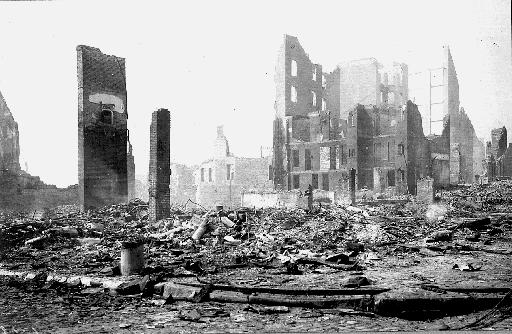 100
years after San Francisco quake
100
years after San Francisco quake
 100
years after San Francisco quake
100
years after San Francisco quake
Read more about the 1906 Great San Francisco Earthquake in the April 2006 Geotimes Benchmarks, now available online.
Early morning, April 18, 1906: A massive 7.8-magnitude earthquake strikes just 3 kilometers off the coast of San Francisco in the Pacific. The San Andreas Fault, not yet named or understood, slipped 430 kilometers in a minute. Houses built on soft "fill" sediments collapsed, and water mains and gas lines broke. Although the earthquake caused extensive damages, it was the breaking gas lines that actually brought down the city, in a series of devastating fires.
On April 18, 1906, a massive earthquake struck San Francisco, Calif., and set off a series of some 50 fires raging across the city. This photograph shows the wreckage of the Emporium Building on Market Street in the wake of the quake and fires. Photo is courtesy of the U.S. Geological Survey.
One hundred years later, the "City by the Bay" is alive and well. To mark the anniversary of the Great San Francisco Earthquake, thousands of geologists, engineers, politicians, emergency responders and interested members of the public are descending on downtown San Francisco for a three-day conference this week on earthquakes and related events commemorating the 1906 event. If you're in San Francisco this month, be sure to check out some of the special earthquake events and exhibits.
But no matter when you head to the Bay Area, the list of geologically interesting locations to visit is long and varied, from Point Reyes National Seashore just north of the city, where you can actually see the San Andreas Fault and the 6 meters of displacement caused by the 1906 quake, to the serpentinite hills of Marin County and Mount Tamalpais State Park. A stroll through the city, however, will give you a unique perspective on the 1906 quake and the ensuing fire that consumed the city.
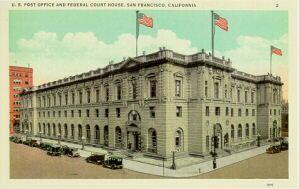 One of
the most famous buildings still standing in the wake of the quake and fire would
be a good place to begin an earthquake-inspired tour of the city: the U.S. Court
of Appeals building.
One of
the most famous buildings still standing in the wake of the quake and fire would
be a good place to begin an earthquake-inspired tour of the city: the U.S. Court
of Appeals building.
If you're visiting San Francisco, consider following the trail of the 1906 earthquake, and starting with the old post office building, now housing a U.S. Court of Appeals, at Seventh & Mission streets in downtown San Francisco, as pictured here in a 1905 postcard. Photo is courtesy of the National Park Service.
In the heart of downtown San Francisco, at Seventh and Mission streets, the Court of Appeals building was completed in 1905 as a federal courthouse and post office and is on the National Register of Historic Places. A quick tour inside reveals walls and columns of marble from Vermont and Maryland, as well as Italy and North Africa; rich mahogany from Mexico and East India; and local California redwood.
The courthouse was spared extensive damage in the 1906 quake and fire, so it was restored pretty quickly. The 1989 Loma Prieta temblor did, however, badly damage the building. Luckily for visitors today, the U.S. General Services Administration chose to restore it to its former glory, and actually retrofitted it to withstand future temblors, by putting an innovative base-isolation system beneath it.
After your quick tour, step back outside and walk a few blocks up Market Street toward Union Square, which was leveled in the 1906 quake, but was quickly rebuilt and became the city's premier shopping district. Today, Union Square hosts a multitude of hotels and restaurants at varying price levels (though none are very cheap), and boutique and department stores galore. If you can afford it, it's a good place to stay, as it is close to everything.
On the way, though, grab a map of the city at the San Francisco Visitors Center near the Powell Street BART (Bay Area Rapid Transit) station (a couple blocks shy of the square) — the start of the Powell/Hyde and Powell/Mason cable car lines. Hop aboard one of San Francisco's famed cable cars, which will take you to Fisherman's Wharf, via Union Square.
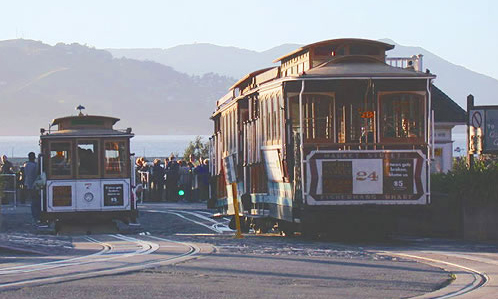 The cable
cars nearly lost out to streetcars following the earthquake, as you learn at
the Cable Car Museum. The quake damaged the 30-year-old
cable car system, and the advent of the streetcar and the trolley bus (both
popular modes of transportation in the city) led to the system's near demise
by the 1940s. In 1947, the city voted to save the three lines that are still
running today.
The cable
cars nearly lost out to streetcars following the earthquake, as you learn at
the Cable Car Museum. The quake damaged the 30-year-old
cable car system, and the advent of the streetcar and the trolley bus (both
popular modes of transportation in the city) led to the system's near demise
by the 1940s. In 1947, the city voted to save the three lines that are still
running today.
San Francisco's famed cable cars are worth the fare just to experience a century-plus-old tradition, but they're also a good way to get from downtown to Fisherman's Wharf, as pictured here, and back. Stop by the Cable Car Museum atop Nob Hill for a look at the history of the system. Photo courtesy of Friends of the Cable Car Museum.
If you're going to be walking the city for the day or for several days, get a single- or multi-day pass — it will save you money and a lot of huffing and puffing as you try to navigate the city's notorious hills.
In the shadow of one famous hill, Nob Hill, lies Chinatown, a fascinating look at the Gateway to the East and some good, inexpensive food as well. Atop Nob Hill are the Cable Car Museum and some of the most expensive hotels and mansions in the city, only two of which survived the 1906 quake and fire, including the Flood Mansion (now the exclusive Pacific-Union Club, not open to the public) and the exquisite Fairmont Hotel, which was gutted by the fire.
Get back on the cable car (or walk, if you are ambitious) down Nob Hill toward Russian Hill. Atop Russian Hill, along Hyde Street, tourists can jump off the Powell/Hyde cable car and wander down Lombard Street, called the "crookedest street in the world," past stately Victorian mansions. Keep going on Lombard until you reach Columbus Street, and you'll find some fantastic dining in North Beach, San Francisco's Little Italy.
North Beach is also where you'll find the beginnings of the Bank of America,
and another important stop along the earthquake trail. As geologist Lisa Rossbacher
wrote in a July 2005 Geotimes column, owner A.P.
Giannini saved the Bank of Italy from the inferno by filling a horse-drawn wagon
with $2 million in gold and securities, covering the valuables with vegetables,
and heading toward Fisherman's Wharf. The day after the quake struck, Giannini
opened for business. 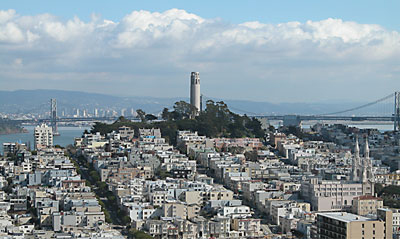
From the gold reserves he saved from the fire, Giannini granted many of the
loans that were used to rebuild San Francisco, as the quake and fire destroyed
most of the other banks. In 1929, Giannini bought out Bank of America for the
name. Although Bank of America is no longer headquartered in San Francisco,
a walk through North Beach could give you a sense of the days of yore, with
old-fashioned restaurants, shops and the beautiful expanse of green at Washington
Square.
Coit Tower atop Telegraph Hill offers great views of San Francisco, if visitors can make the climb up there. The tower was built with money left to the city by Lillie Hitchcock-Coit, the patroness of San Francisco's firefighters, who admired their work during the blazes following the 1906 earthquake. Photo by Lewis Sommer is courtesy of the San Francisco Convention & Visitors Bureau.
After some pasta and gelato, head up Telegraph Hill to Coit Tower, which offers
spectacular views of the city and San Francisco Bay, and is yet another reminder
of the earthquake and fire. Coit Tower was built with money bequeathed to the
city by Lillie Hitchcock-Coit, a turn-of-the-century patroness of the firefighters
of San Francisco. The tower resembles a fire hose nozzle, and thanks to residents
and volunteer firefighters, many of the houses atop the hill were able to survive
the fire in 1906.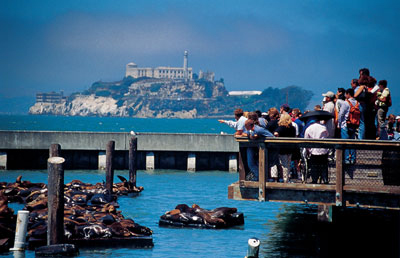
From Telegraph Hill, head down the hill toward the water and Fisherman's Wharf. Check out the Aquarium of the Bay, take photos of the throngs of sea lions lying on the rocks and piers sunning themselves, and enjoy the beginning of the restaurants, shops and hotels that line the wharf. The area is a tourist trap and usually crowded.
Visitors can catch a ferry to Alcatrez Island, pictured here, from Fisherman's Wharf — also a great place to watch sea lions lounging in the sun. Photo by Jeff Greenberg is courtesy of the San Francisco Convention & Visitors Bureau.
At Pier 41, you can catch the ferry to Alcatraz, now a national park. It has nothing to do with the earthquake, but visiting "the rock" is just cool from both a geologic and a historic viewpoint. Ferries leave frequently throughout the day both to and from Alcatraz, but beware that tickets sell out quickly during tourist season so get there early or book ahead of time.
Farther along the wharf, you'll come across the Boudin Bakery museum, home of the city's famous sourdough bread that has been around since 1849 (though it was originally headquartered in the French Quarter downtown), and finally to Ghirardelli Square, home to the Ghirardelli Soda Fountain and Chocolate Shop, and quaint shops and restaurants.
The red brick edifice of Ghirardelli Square is what remains of the Ghirardelli chocolate factory, which Ghirardelli bought in 1893 to house the growing factory. The factory survived the 1906 quake and fire relatively unscathed, and remained the headquarters of the chocolate giant until the mid-20th century when the edifice was turned into the tourist site that it is today. No visit to the city is complete without stopping into the Soda Fountain, and trying the decadent hot fudge sundae or hot chocolate.
You might want to grab a cab or a bus to head farther along the coastline toward the Golden Gate Bridge, by way of the Palace of Fine Arts and the Presidio, a former military facility recently converted to a national park. The park marks the first chance to explore the 200- to 100-million-year-old serpentinite cliffs that continue in nearby Marin County. Just past the Golden Gate Bridge is Golden Gate Bridge State Park, which is also a pretty place to explore.
 After
your outdoors extravaganza, head indoors to almost any museum in the city to
learn more about the Great Earthquake and see photography, paintings and drawings
and other works of art and science on the event. Try the Legion of Honor (an
art museum), the San Francisco Museum of Modern Art, the Exploratorium (a terrific
scientific adventure in its own right), the Museum of the City of San Francisco,
or the California Historical Society, among others. Many of the earthquake exhibits
at these museums are short-lived, only planned through May or June, so be sure
to stop by soon.
After
your outdoors extravaganza, head indoors to almost any museum in the city to
learn more about the Great Earthquake and see photography, paintings and drawings
and other works of art and science on the event. Try the Legion of Honor (an
art museum), the San Francisco Museum of Modern Art, the Exploratorium (a terrific
scientific adventure in its own right), the Museum of the City of San Francisco,
or the California Historical Society, among others. Many of the earthquake exhibits
at these museums are short-lived, only planned through May or June, so be sure
to stop by soon.
In the shadow of the Golden Gate Bridge, from the Presidio (now a national park), visitors can explore the serpentinite hills that continue into nearby Marin County. Photo is courtesy of the National Park Service.
Also, don't be deterred by the rainy weather reports you've heard recently. Despite recent heavy rainfall, late spring and summer in Northern California are usually dry and a nice time to visit with temperatures usually around 70 degrees Fahrenheit. However, do heed Mark Twain's alleged comment, "The coldest winter I ever saw was the summer I spent in San Francisco," and be sure to bring a light jacket. (There's no easier way to spot a tourist than seeing someone in shorts and a new fleece emblazoned with an embroidered Golden Gate Bridge and the words "San Francisco.")
But whether you're tracing historical locations of the 1906 earthquake or just traveling through San Francisco and the Bay Area, be aware of your surroundings — researchers say it's not a question of "if" the San Andreas will shake San Francisco again, it's a matter of "when."
Megan Sever
Links:
1906
Earthquake Centennial Alliance
The
Presidio
Point
Reyes National Seashore
Geology
of Golden Gate State Park
Exploratorium
U.S.
Geological Survey information on the quake
U.S.
Geological Survey shake map on the 1906 event
Internet
tours of San Francisco
San
Francisco Convention & Visitor's Bureau
Cable
Car Museum
"Banking on Earthquakes," Geotimes,
July 2005
"The Great Earthquake
Destroys San Francisco," Geotimes, April 2006
Travels in Geology
 |
Geotimes Home | AGI Home | Information Services | Geoscience Education | Public Policy | Programs | Publications | Careers |